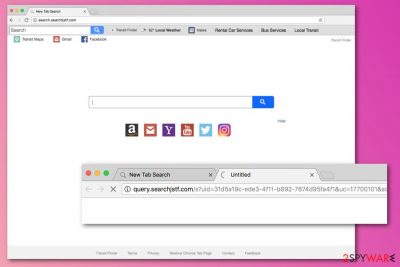Search.searchjstf.com (Tutorial) - Removal Guide
Search.searchjstf.com Removal Guide
What is Search.searchjstf.com?
Search.searchjstf.com is a shady search engine

Search.searchjstf.com is a potentially unwanted program (PUP) that is designed to take control over web browsers. Created by Polarity Technologies, this browser hijacker spreads in software bundles as Transit Finder app and can sneak unnoticed. However, it immediately changes browser’s startup page and starts other annoying activities.
| Summary | |
|---|---|
| Name | Search.searchjstf.com |
| Type | Browser hijacker |
| Danger level | Medium. Modifies browser's settings and might display potentially dangerous content |
| Developers | Polarity Technologies |
| Symptoms | Changed browser's homepage and search engine, inability to set preferred search engine, an increased amount of ads |
| Targeted browsers | Google Chrome, Mozilla Firefox, Internet Explorer, Safari |
| Distribution | Software bundles |
| To uninstallSearch.searchjstf.com, install FortectIntego and run a full system scan | |
Users often refer to this potentially unwanted app as a Search.searchjstf.com virus. However, it’s too strong term to describe this cyber threat. It cannot harm the computer directly, corrupt files or steal sensitive data. However, its infiltration definitely increases a possibility to meet dangerous viruses online.[1]
Search.searchjstf.com can affect Chrome, Firefox or other commonly used browsers and alter their settings. The browser hijacker might also make some changes to the system or install helper objects to keep control over the browser. For this reason, users might find it difficult to get rid of it from the browser.
The PUP alters browsers homepage, default search engine, and new tab URL address. According to the researchers from semvirus.pt,[2] it might set either hxxp://search.searchjstf.com and hxxp://query.searchjstf.com instead of the default browser startup page.
However, this search engine might seem legitimate because it offers quick access to popular social networks and redirects search queries to Yahoo results page. The problem is that authors of the hijacker do not have a purpose of enhancing your browsing sessions. All they want is you to visit sponsored sites or click on ads. However, you should not do it!
Search.searchjstf.com redirect tendencies are really concerning. When you click on a search link, the hijacker might trigger another redirect to the affiliate website. Hence, instead of opening needed source, you might be visiting phishing[3] or infected site.
The same problem exists with ads too. However, here developers use another trick. The PUP can collect various information which allows identifying user’s interests and browsing habits. Based on this knowledge, they can display targeted ads, which means that they might look interesting and useful. But we want to warn that commercial content is usually misleading and you should stay away from it.
As soon as you find out about the hijacked web browser, you should obtain reputable anti-malware software and scan your computer. Our team suggests using FortectIntego for Search.searchjstf.com removal. However, any reliable and up-to-date tool can help you too.
We are aware that not everyone wants to use third-party software to remove Search.searchjstf.com and all its related components. For this reason, we created detailed instructions on how to get rid of the browser hijacker without security program. You can find them below.

Be careful with freeware downloads
Freeware and shareware are the main tools used in hijacker’s distribution. Developers of any free program can include additional apps in a freeware installer for a specific sum of money. There’s no doubt that authors of PUPs are very interested in such marketing and distribution strategy.
The advantage of this technique is that PUPs can be hidden under Quick or Standard settings which do not openly disclose about third-party apps. Therefore, when users decide to use this setup, they give indirect permission to install the whole freeware bundle.
It’s possible to avoid this mistake if you use Advanced or Custom installation of a free program. However, choosing these settings is not enough. You have to read notifications in each of the steps and opt out pre-selected optional apps.
Eliminate Search.searchjstf.com for good
As you already know, it’s possible to remove Search.searchjstf.com automatically and manually. If you are here for the latter option, you should scroll down a little bit more where the guide is. However, we want to point out at a couple of important steps:
- Uninstall Transit Finder and other suspicious extensions from each of the browsers installed on your PC.
- Reset browsers.
- Uninstall all programs from the computer that might be associated with the hijacker.
However, if it seems a complicated task or you have failed with manual Search.searchjstf.com removal, you should not waste your time and choose security program for the automatic elimination.
You may remove virus damage with a help of FortectIntego. SpyHunter 5Combo Cleaner and Malwarebytes are recommended to detect potentially unwanted programs and viruses with all their files and registry entries that are related to them.
Getting rid of Search.searchjstf.com. Follow these steps
Uninstall from Windows
These guidelines will help you to get rid of hijacker-related entries from Windows:
Instructions for Windows 10/8 machines:
- Enter Control Panel into Windows search box and hit Enter or click on the search result.
- Under Programs, select Uninstall a program.

- From the list, find the entry of the suspicious program.
- Right-click on the application and select Uninstall.
- If User Account Control shows up, click Yes.
- Wait till uninstallation process is complete and click OK.

If you are Windows 7/XP user, proceed with the following instructions:
- Click on Windows Start > Control Panel located on the right pane (if you are Windows XP user, click on Add/Remove Programs).
- In Control Panel, select Programs > Uninstall a program.

- Pick the unwanted application by clicking on it once.
- At the top, click Uninstall/Change.
- In the confirmation prompt, pick Yes.
- Click OK once the removal process is finished.
Delete from macOS
Remove items from Applications folder:
- From the menu bar, select Go > Applications.
- In the Applications folder, look for all related entries.
- Click on the app and drag it to Trash (or right-click and pick Move to Trash)

To fully remove an unwanted app, you need to access Application Support, LaunchAgents, and LaunchDaemons folders and delete relevant files:
- Select Go > Go to Folder.
- Enter /Library/Application Support and click Go or press Enter.
- In the Application Support folder, look for any dubious entries and then delete them.
- Now enter /Library/LaunchAgents and /Library/LaunchDaemons folders the same way and terminate all the related .plist files.

Remove from Microsoft Edge
Delete unwanted extensions from MS Edge:
- Select Menu (three horizontal dots at the top-right of the browser window) and pick Extensions.
- From the list, pick the extension and click on the Gear icon.
- Click on Uninstall at the bottom.

Clear cookies and other browser data:
- Click on the Menu (three horizontal dots at the top-right of the browser window) and select Privacy & security.
- Under Clear browsing data, pick Choose what to clear.
- Select everything (apart from passwords, although you might want to include Media licenses as well, if applicable) and click on Clear.

Restore new tab and homepage settings:
- Click the menu icon and choose Settings.
- Then find On startup section.
- Click Disable if you found any suspicious domain.
Reset MS Edge if the above steps did not work:
- Press on Ctrl + Shift + Esc to open Task Manager.
- Click on More details arrow at the bottom of the window.
- Select Details tab.
- Now scroll down and locate every entry with Microsoft Edge name in it. Right-click on each of them and select End Task to stop MS Edge from running.

If this solution failed to help you, you need to use an advanced Edge reset method. Note that you need to backup your data before proceeding.
- Find the following folder on your computer: C:\\Users\\%username%\\AppData\\Local\\Packages\\Microsoft.MicrosoftEdge_8wekyb3d8bbwe.
- Press Ctrl + A on your keyboard to select all folders.
- Right-click on them and pick Delete

- Now right-click on the Start button and pick Windows PowerShell (Admin).
- When the new window opens, copy and paste the following command, and then press Enter:
Get-AppXPackage -AllUsers -Name Microsoft.MicrosoftEdge | Foreach {Add-AppxPackage -DisableDevelopmentMode -Register “$($_.InstallLocation)\\AppXManifest.xml” -Verbose

Instructions for Chromium-based Edge
Delete extensions from MS Edge (Chromium):
- Open Edge and click select Settings > Extensions.
- Delete unwanted extensions by clicking Remove.

Clear cache and site data:
- Click on Menu and go to Settings.
- Select Privacy, search and services.
- Under Clear browsing data, pick Choose what to clear.
- Under Time range, pick All time.
- Select Clear now.

Reset Chromium-based MS Edge:
- Click on Menu and select Settings.
- On the left side, pick Reset settings.
- Select Restore settings to their default values.
- Confirm with Reset.

Remove from Mozilla Firefox (FF)
Remove dangerous extensions:
- Open Mozilla Firefox browser and click on the Menu (three horizontal lines at the top-right of the window).
- Select Add-ons.
- In here, select unwanted plugin and click Remove.

Reset the homepage:
- Click three horizontal lines at the top right corner to open the menu.
- Choose Options.
- Under Home options, enter your preferred site that will open every time you newly open the Mozilla Firefox.
Clear cookies and site data:
- Click Menu and pick Settings.
- Go to Privacy & Security section.
- Scroll down to locate Cookies and Site Data.
- Click on Clear Data…
- Select Cookies and Site Data, as well as Cached Web Content and press Clear.

Reset Mozilla Firefox
If clearing the browser as explained above did not help, reset Mozilla Firefox:
- Open Mozilla Firefox browser and click the Menu.
- Go to Help and then choose Troubleshooting Information.

- Under Give Firefox a tune up section, click on Refresh Firefox…
- Once the pop-up shows up, confirm the action by pressing on Refresh Firefox.

Remove from Google Chrome
Uninstall all add-ons and extensions that seem to be associated with Search.searchjstf.com:
Delete malicious extensions from Google Chrome:
- Open Google Chrome, click on the Menu (three vertical dots at the top-right corner) and select More tools > Extensions.
- In the newly opened window, you will see all the installed extensions. Uninstall all the suspicious plugins that might be related to the unwanted program by clicking Remove.

Clear cache and web data from Chrome:
- Click on Menu and pick Settings.
- Under Privacy and security, select Clear browsing data.
- Select Browsing history, Cookies and other site data, as well as Cached images and files.
- Click Clear data.

Change your homepage:
- Click menu and choose Settings.
- Look for a suspicious site in the On startup section.
- Click on Open a specific or set of pages and click on three dots to find the Remove option.
Reset Google Chrome:
If the previous methods did not help you, reset Google Chrome to eliminate all the unwanted components:
- Click on Menu and select Settings.
- In the Settings, scroll down and click Advanced.
- Scroll down and locate Reset and clean up section.
- Now click Restore settings to their original defaults.
- Confirm with Reset settings.

Delete from Safari
Remove unwanted extensions from Safari:
- Click Safari > Preferences…
- In the new window, pick Extensions.
- Select the unwanted extension and select Uninstall.

Clear cookies and other website data from Safari:
- Click Safari > Clear History…
- From the drop-down menu under Clear, pick all history.
- Confirm with Clear History.

Reset Safari if the above-mentioned steps did not help you:
- Click Safari > Preferences…
- Go to Advanced tab.
- Tick the Show Develop menu in menu bar.
- From the menu bar, click Develop, and then select Empty Caches.

After uninstalling this potentially unwanted program (PUP) and fixing each of your web browsers, we recommend you to scan your PC system with a reputable anti-spyware. This will help you to get rid of Search.searchjstf.com registry traces and will also identify related parasites or possible malware infections on your computer. For that you can use our top-rated malware remover: FortectIntego, SpyHunter 5Combo Cleaner or Malwarebytes.
How to prevent from getting stealing programs
Protect your privacy – employ a VPN
There are several ways how to make your online time more private – you can access an incognito tab. However, there is no secret that even in this mode, you are tracked for advertising purposes. There is a way to add an extra layer of protection and create a completely anonymous web browsing practice with the help of Private Internet Access VPN. This software reroutes traffic through different servers, thus leaving your IP address and geolocation in disguise. Besides, it is based on a strict no-log policy, meaning that no data will be recorded, leaked, and available for both first and third parties. The combination of a secure web browser and Private Internet Access VPN will let you browse the Internet without a feeling of being spied or targeted by criminals.
No backups? No problem. Use a data recovery tool
If you wonder how data loss can occur, you should not look any further for answers – human errors, malware attacks, hardware failures, power cuts, natural disasters, or even simple negligence. In some cases, lost files are extremely important, and many straight out panic when such an unfortunate course of events happen. Due to this, you should always ensure that you prepare proper data backups on a regular basis.
If you were caught by surprise and did not have any backups to restore your files from, not everything is lost. Data Recovery Pro is one of the leading file recovery solutions you can find on the market – it is likely to restore even lost emails or data located on an external device.
- ^ Manpreet Singh. Top 20 Most Dangerous Computer Viruses Of All Time. Tech Viral. Hacker news, tech news and tech hacks.
- ^ SemVirus. SemVirus. Portuguese cyber security news.
- ^ How to Spot a Phishing Website. GlobalSign Blog. IT news.























